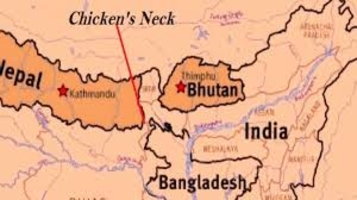India Reportedly Expands Control by 60 km into “Chicken’s Neck” Corridor
A Strategic Shift That Could Redefine South Asian Geopolitics
Poonam Sharma
According to unverified reports, in what could turn out to be one of the most dramatic strategic developments in South Asia in recent years, Indian forces have silently extended their operational control by almost 60 kilometers into the region popularly known as the “Chicken’s Neck.” This is a narrow corridor that links mainland India to its northeastern states and has long been regarded as India’s most vulnerable geographical point, militarily and geopolitically.
According to preliminary sources, the reported advancement involves the absorption of a significant land portion that previously lay within Bangladesh’s frontier, an area which in times past had confusion and overlying claims because of old cartographic ambiguities. While official statements from both India and Bangladesh are yet to confirm the incident, the mere circulation of this news has created deep curiosity, strategic debate, and cautious optimism in Indian defense circles.
The Chicken’s Neck: India’s Strategic Lifeline
The Chicken’s Neck, also known technically as the Siliguri Corridor, is a narrow strip of land in North Bengal. It connects the rest of India with its eight northeastern states. Barely 22 kilometers wide at its narrowest point, this corridor borders Nepal, Bhutan, and Bangladesh. In short, this is an extremely sensitive and militarily delicate zone. Any disruption here could effectively cut off the northeastern states from the Indian mainland.
India has been building up this area with infrastructure and surveillance for decades, knowing full well it is the Achilles heel of the nation’s defense architecture. The reports, if true, thus could mean a strategic deepening of India’s territorial hold, but not necessarily through conflict; rather, this can be through discreet realignments on the ground, supported by intelligence and local coordination.
The Mysterious Role of Yunus Molla and a Pakistani Connection
Adding a layer of intrigue to the reports, there are allegations that one Yunus Molla, a relatively unknown Bangladeshi intermediary with connections to the local administrative circles, was involved in “map exchanges” or cartographic negotiations with a high-ranking Pakistani military officer described as “second only to a Field Marshal.” With the veracity of these claims remaining open to question, the mention of such cross-border “map diplomacy” has sparked off speculations on the presence of back-room exchanges aimed at muddling the situation in the region.
Analysts explain this move as an attempt to create disinformation or territorial ambiguity by Pakistan’s intelligence ecosystem with regard to India’s borders, particularly those that border Bangladesh. This is likened to the psychological and cartographic games played during the Cold War era. Others, however, suggest that these “map dealings” may have inadvertently paved the way for India to consolidate its rightful territorial influence, especially in regions where the historical demarcation remained unclear or poorly monitored.
India’s Silence: A Calculated Calm
Interestingly, the Indian government has not issued any statement regarding the reports so far. The silence, many believe, is strategic rather than accidental .A senior defense analyst based in Guwahati remarked that “if the reports are even partially accurate, New Delhi will neither confirm nor deny immediately-the government will first ensure that any new ground realities are stabilized before making a diplomatic acknowledgment.”
This, of course, is not a new pattern. India has traditionally opted for discretion over publicity on sensitive military matters when quiet consolidation is seen to serve the national interest more effectively than public confrontation. The recent push towards infrastructure, including roads and surveillance systems near the Siliguri Corridor, speaks to this long-term, non-theatrical approach to national security.
Why This Matters for Bangladesh
If the developments are verified, the implications for Bangladesh could be significant but not necessarily adversarial. Much of the regions reportedly brought under Indian administrative reach consist of uninhabited or contested buffer zones in which boundaries have historically been blurred. Dhaka has mostly been cooperative with New Delhi under Prime Minister Sheikh Hasina and might choose to downplay the issue as a means of avoiding diplomatic friction.
However, the opposition forces in Bangladesh may view the case differently: as one of “territorial compromise” or even accuse the government of allowing India to redraw borders quietly. Such a narrative could resonate with nationalist and Islamist groups that already claim Hasina’s government is too accommodating toward India.
A Moment to Watch – and Wait
The story remains unverified at this stage, but the symbolism it carries is huge. If India has indeed expanded its operational boundary by 60 km, this would mark arguably one of the most subtle yet powerful demonstrations of ground-level strategic assertiveness seen in recent history. It would also signal a quiet re-assertion of Indian primacy over a zone that has long been considered geopolitically fragile.
For the meantime, experts say that patience is key. The lack of immediate official response may actually be indicative of verification going on, diplomatic coordination, and security consolidation. As one defensive commentator stated:
“If this is true, then it’s a silent victory — not one for loud headlines but for history books. Whether this remarkable expansion is fact or fiction, it will be confirmed by satellite imagery, local reports, and possible diplomatic correspondence between New Delhi and Dhaka in the coming weeks. Either way, the “Chicken’s Neck” has once again become the pulse point of South Asian geopolitics, reminding the world that in the subcontinent, even a few kilometers of land can carry the weight of entire strategic destinies. –

